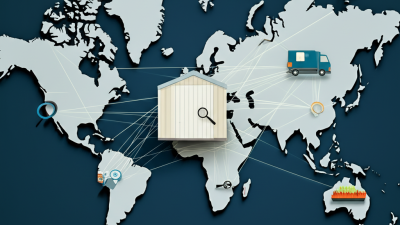Sorry, your browser is not supported. For a better experience, keep your browser up to date. Check here for latest versions
In the ever-evolving landscape of global procurement, professionals face a myriad of challenges that can often complicate their decision-making processes. One such challenge is finding efficient and effective solutions that simplify the complexities of sourcing and supply chain management. This blog delves into the concept of "Easy Shed" solutions, designed to streamline procurement practices and enhance operational efficiency.

By exploring various strategies and approaches that embody the essence of Easy Shed, we will uncover the obstacles that procurement professionals encounter while attempting to implement these innovative solutions.
Furthermore, we will provide valuable insights into how embracing these methodologies not only alleviates pressure but also drives significant improvements in procurement outcomes.
Join us as we navigate through the intricacies of Easy Shed solutions and unveil practical tips for overcoming the challenges faced by global procurement teams.
The rise of China's manufacturing power has significantly impacted global procurement strategies, presenting both opportunities and challenges for procurement professionals. With its ability to produce goods at scale and lower costs, China has become a key player in international supply chains. However, this increase in manufacturing capability also brings about complexities such as supply chain risks, quality control issues, and geopolitical uncertainties.
Procurement professionals must adapt to these challenges by prioritizing strong relationships with suppliers. Building trust and open communication with Chinese manufacturers can lead to improved transparency and reliability, essential factors in today's dynamic market. Additionally, diversifying the supplier base can mitigate risks associated with dependency on a single country for manufacturing needs.
**Tips for procurement professionals:**
1. Regularly assess supplier performance and quality to ensure alignment with your organization's standards.
2. Stay informed about geopolitical developments that may affect trade relationships and adjust procurement strategies accordingly.
3. Invest in technology and analytics to enhance supply chain visibility and make data-driven decisions.
In the realm of procurement, the shift towards easy shed solutions presents unique challenges for professionals. According to the Institute for Supply Management, about 56% of procurement professionals cite supplier reliability as a significant concern when integrating simplified solutions. With the rise of just-in-time inventory practices, this unreliability can lead to disruptions in supply chains, ultimately affecting project timelines and organizational efficiency.
Furthermore, the complexity of global sourcing adds another layer of difficulty. A report from Deloitte indicates that 70% of procurement leaders are struggling with regulatory compliance across various markets, which complicates the adoption of easy shed solutions. This is particularly notable in regions with stringent environmental regulations, where procurement teams must ensure that sustainable practices are maintained without sacrificing convenience. As these professionals navigate the landscape of easy shed solutions, addressing supplier reliability and regulatory compliance will be critical to achieving streamlined procurement processes.
Supply chain disruptions have become a pressing concern for global procurement professionals, affecting sourcing strategies and operational efficiency. Factors such as geopolitical tensions, natural disasters, and the ongoing repercussions of the pandemic have revealed vulnerabilities in traditional supply chains. As companies grapple with these challenges, it is essential for procurement teams to adopt
adaptive strategies that ensure
resilience and flexibility in sourcing.
Tip 1: Diversify your supplier base to reduce dependency on a single source. By engaging suppliers from different regions, businesses can mitigate risks associated with regional disruptions and find alternative solutions more quickly.
The impact of these disruptions can be profound, leading to
delays in product availability and increased costs. To navigate these challenges, procurement professionals should
leverage technology for better visibility in their supply chain. Implementing data analytics tools can help identify potential risks before they affect sourcing decisions.
Tip 2: Regularly review and update your risk management plan. Establishing a clear protocol for dealing with disruptions will not only expedite your response but also strengthen your overall procurement strategy. Additionally, consider building strategic partnerships with key suppliers to foster collaboration and
innovation that can enhance supply chain robustness.
In the rapidly evolving landscape of global procurement, the integration of data analytics has emerged as a pivotal strategy for enhancing operational efficiency. As we look toward 2025, the global procurement market is projected to reach a staggering value of $21.34 billion, with an anticipated compound annual growth rate (CAGR) of 35.85 billion by 2033. This growth underscores the critical need for procurement professionals to leverage advanced analytics for smarter decision-making and improved supplier management.
To navigate these challenges effectively, procurement teams must focus on adopting robust data analytics tools. By utilizing predictive analytics, organizations can foresee market trends and adjust their procurement strategies accordingly. Additionally, implementing real-time data monitoring can help identify potential supply chain disruptions before they escalate.
Tips:
As the world increasingly prioritizes sustainability, the manufacturing sector faces significant pressure to adapt. According to a recent report by the Global Manufacturing Association, about 70% of manufacturers worldwide are now integrating sustainable practices into their operations. This shift is particularly evident in China, which has emerged as a leader in green manufacturing technologies, such as renewable energy utilization and waste reduction strategies. China's push towards sustainability is not just a domestic phenomenon; it positions the country as a critical player in global supply chains.
Emerging trends suggest a growing investment in sustainable materials and circular economy practices, which can lead to substantial cost savings. A study by McKinsey & Company indicates that companies actively pursuing sustainable manufacturing stand to reduce their operational costs by up to 20% over the next decade. This trend not only benefits the environment but also enhances competitiveness in the global market. China’s ability to innovate in sustainable processes will open new opportunities for global procurement professionals, pushing them to rethink sourcing strategies while aligning with the ethical demands of today's consumers.